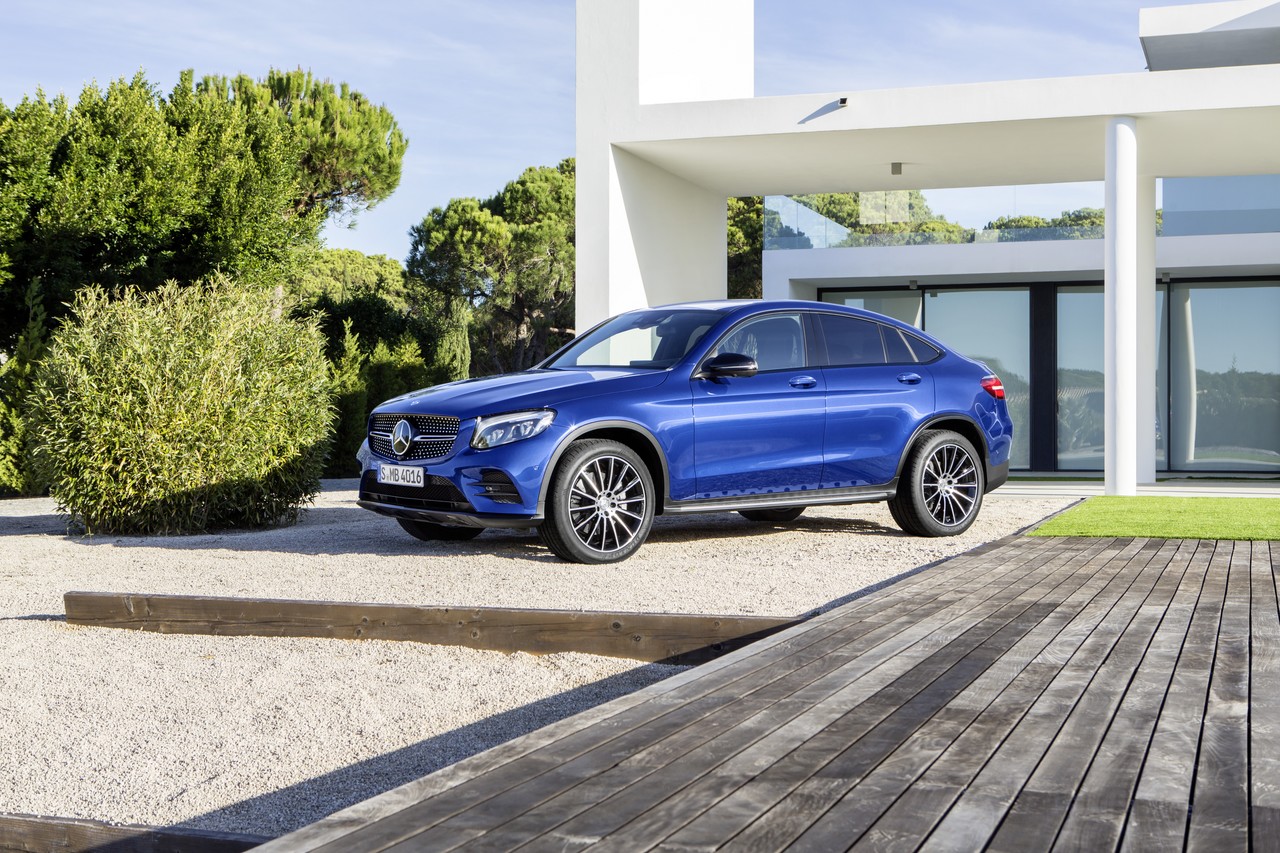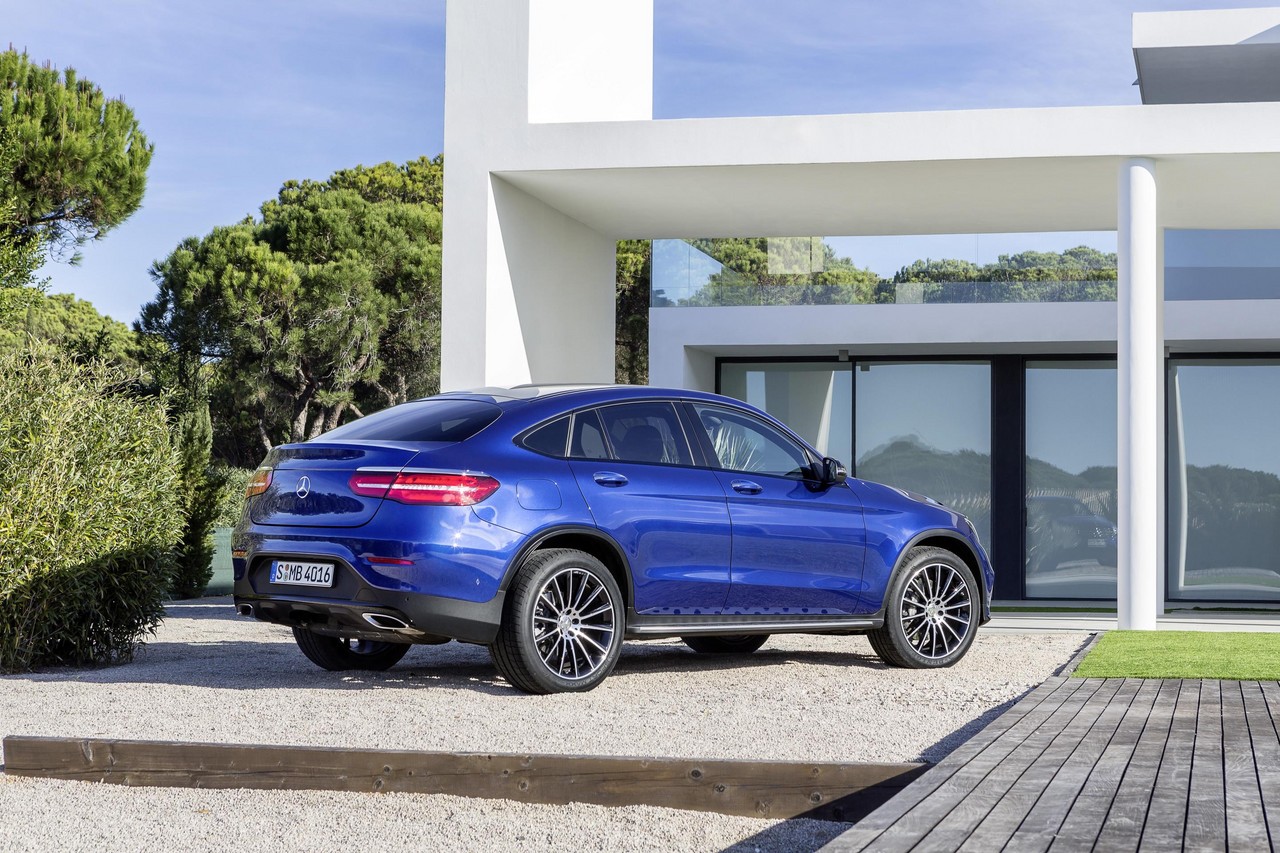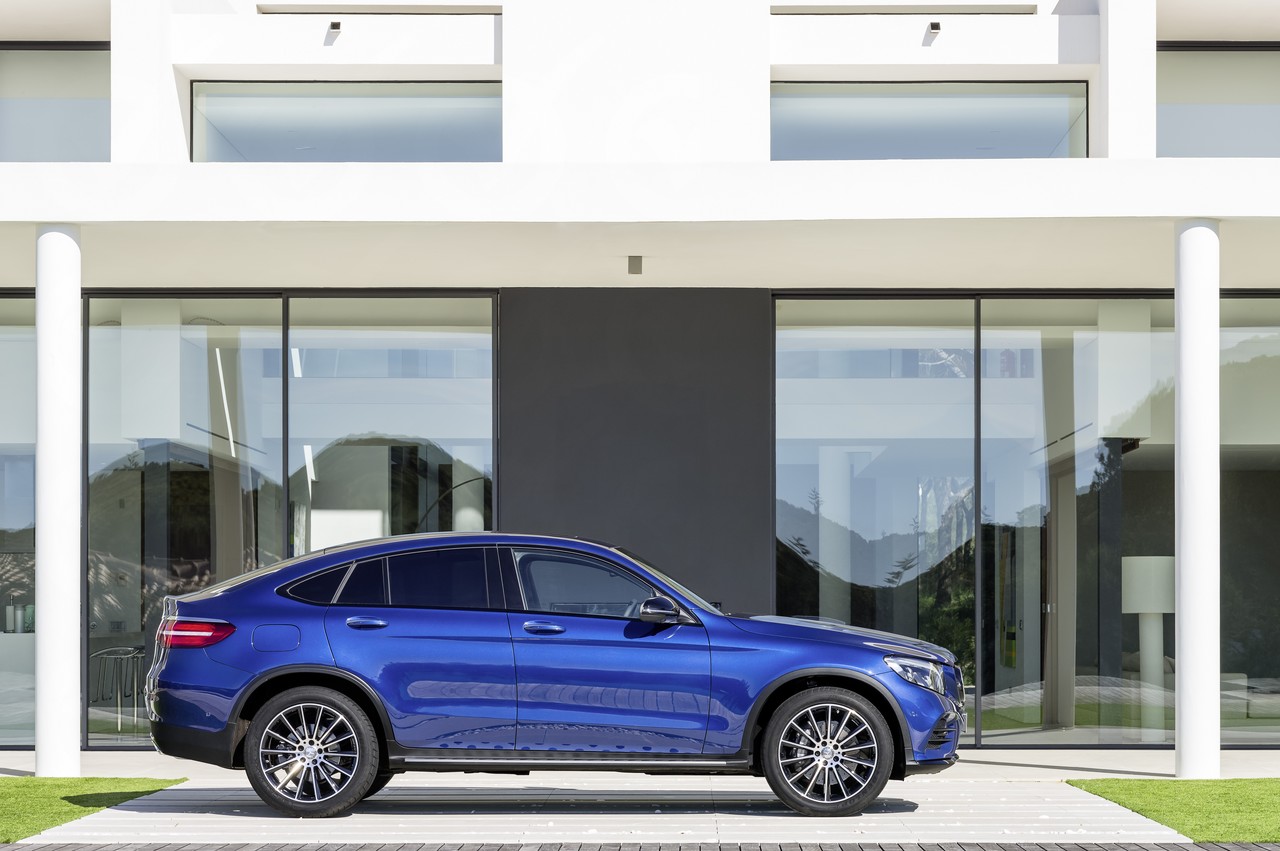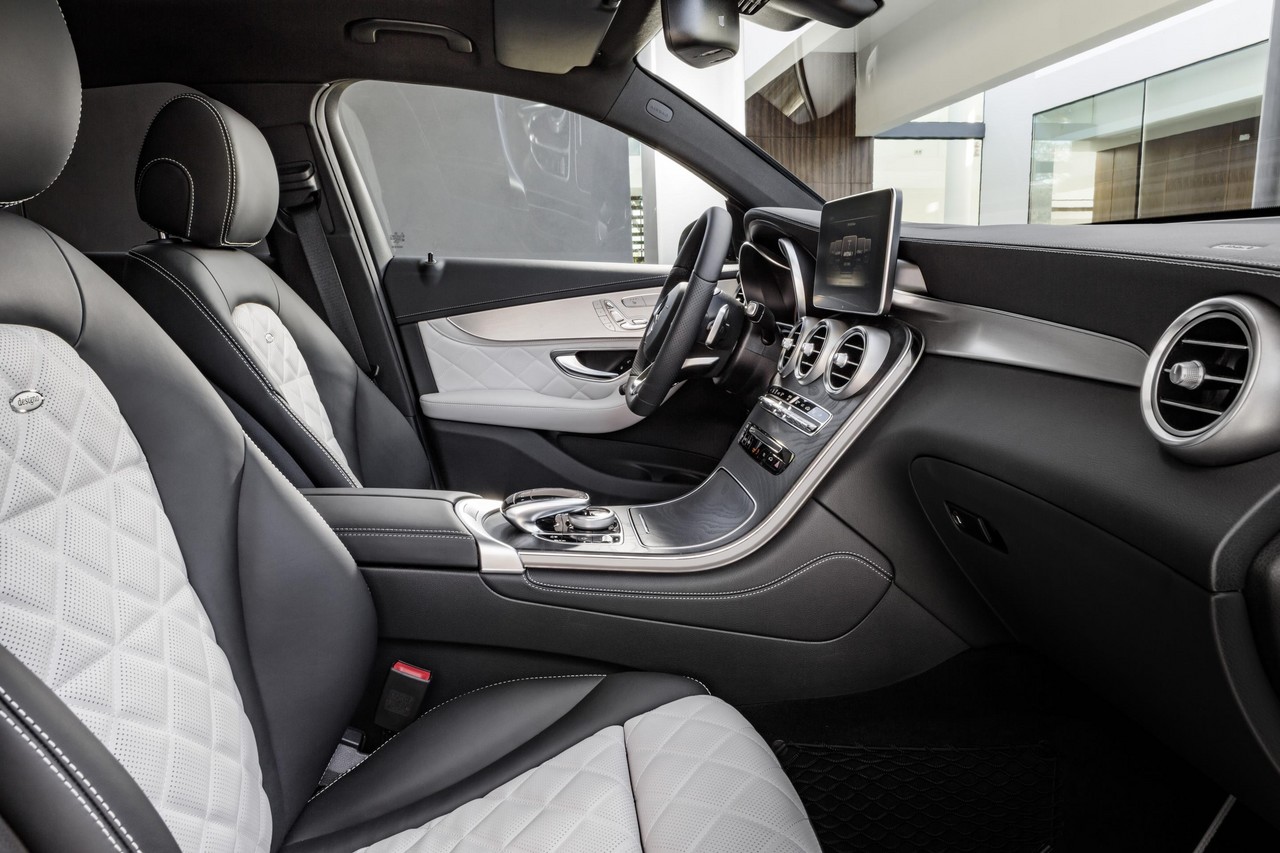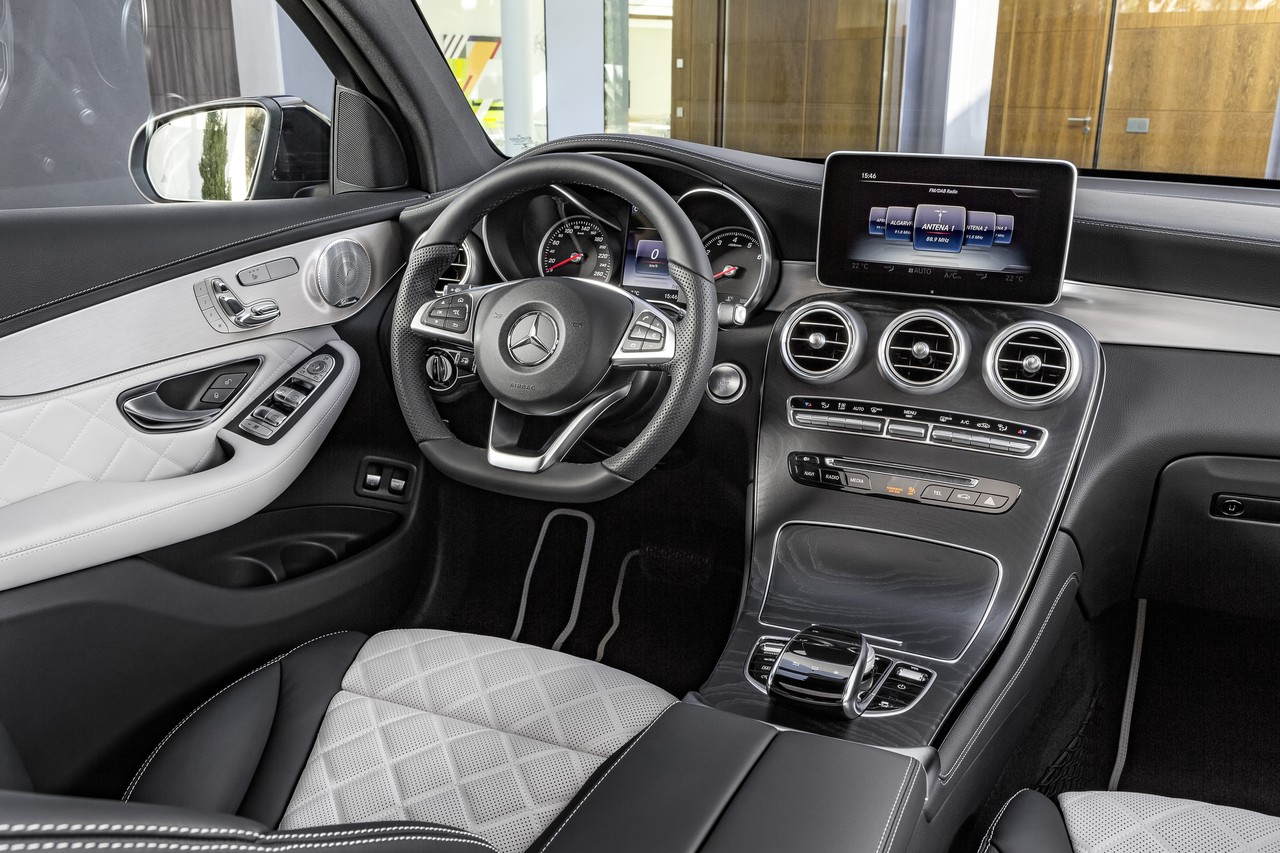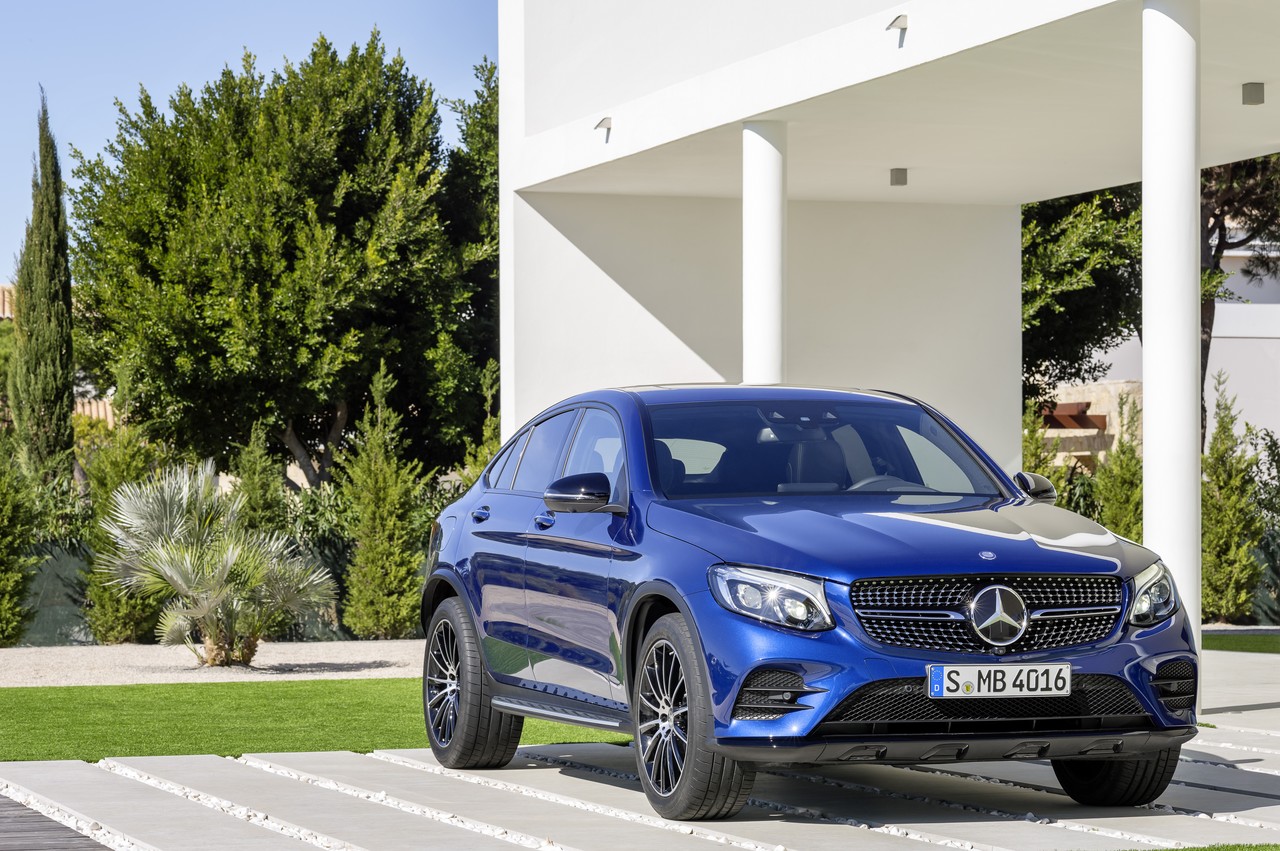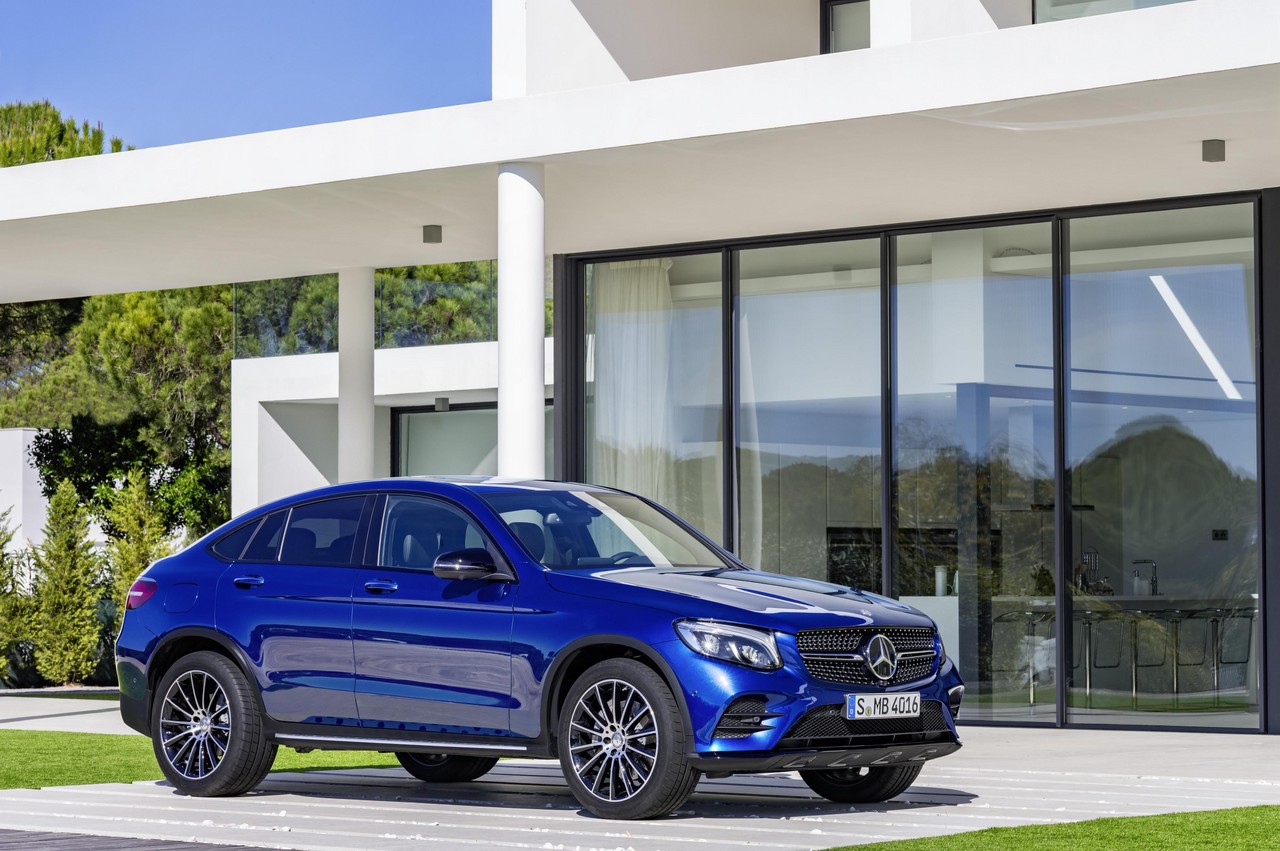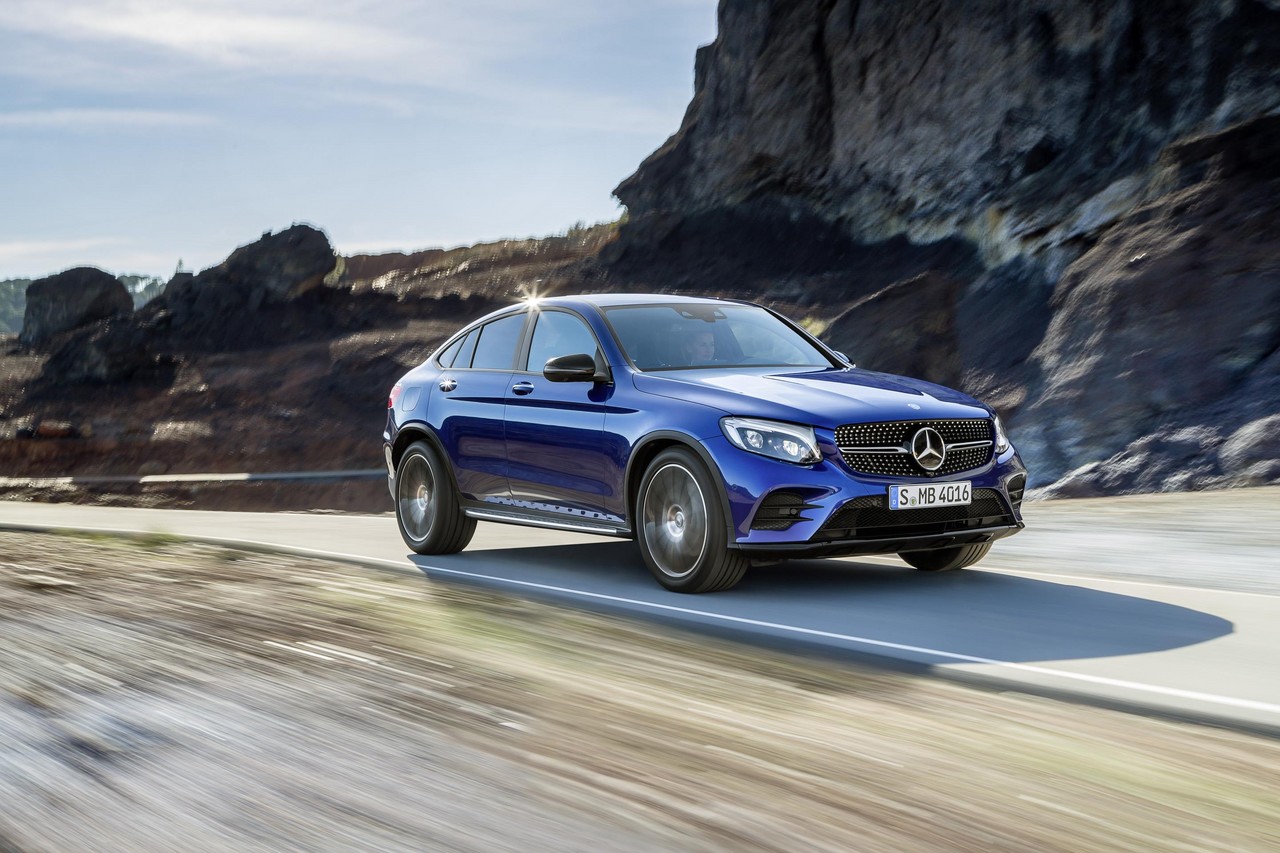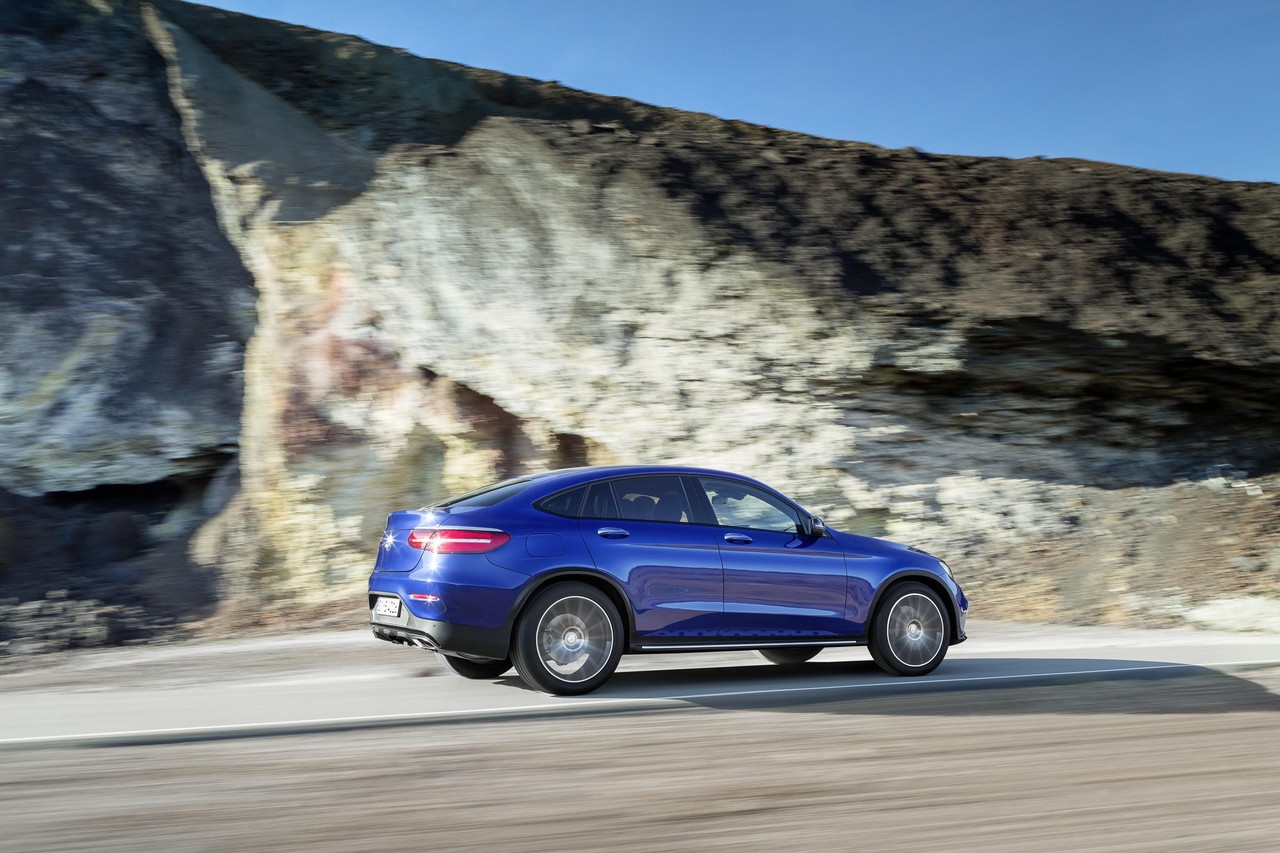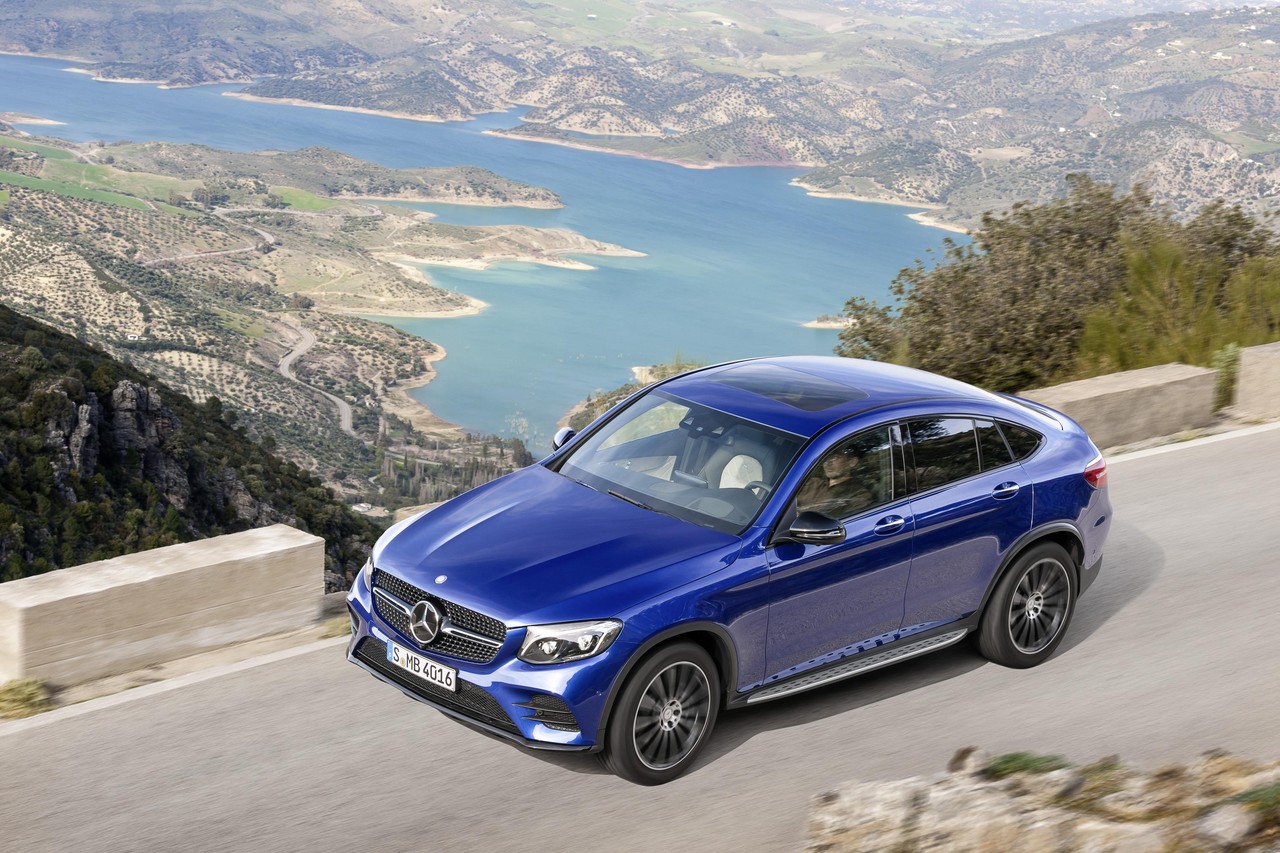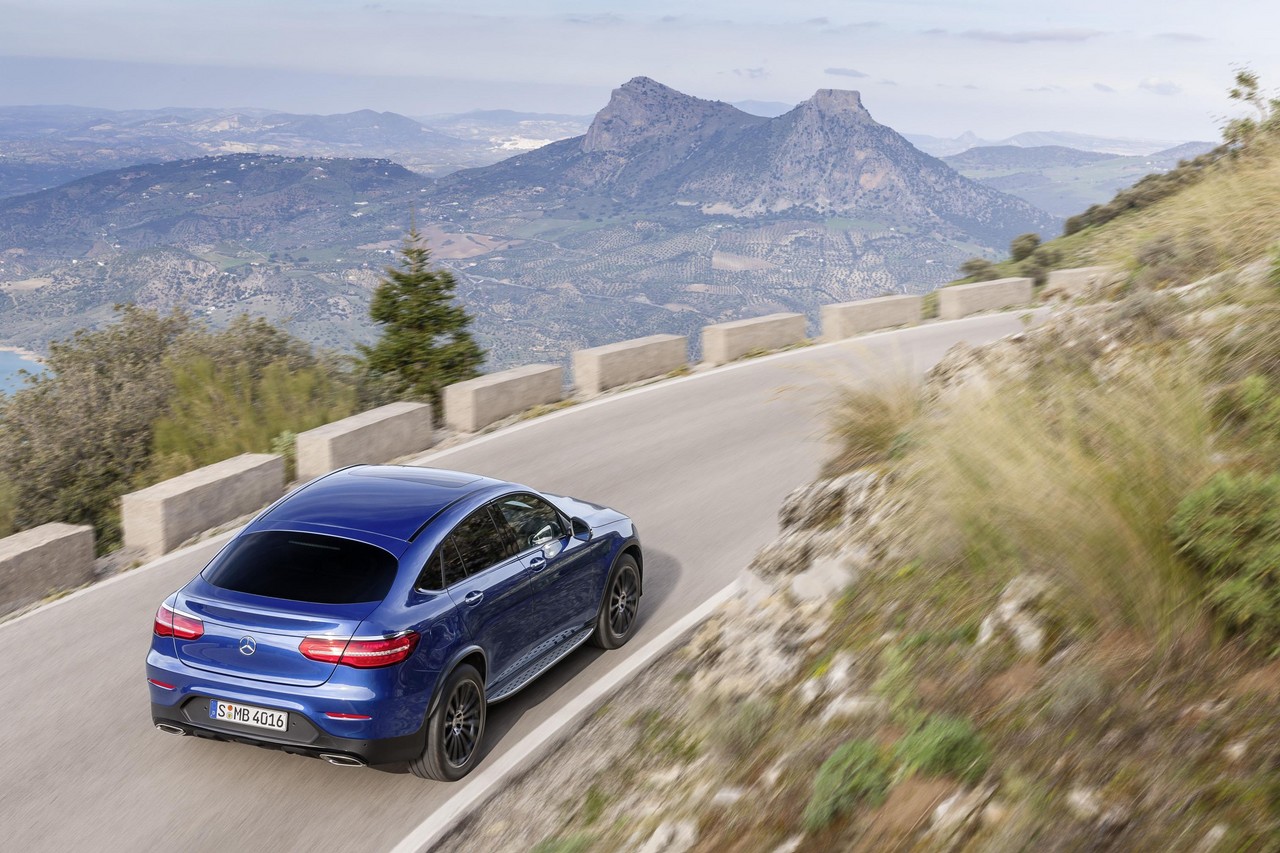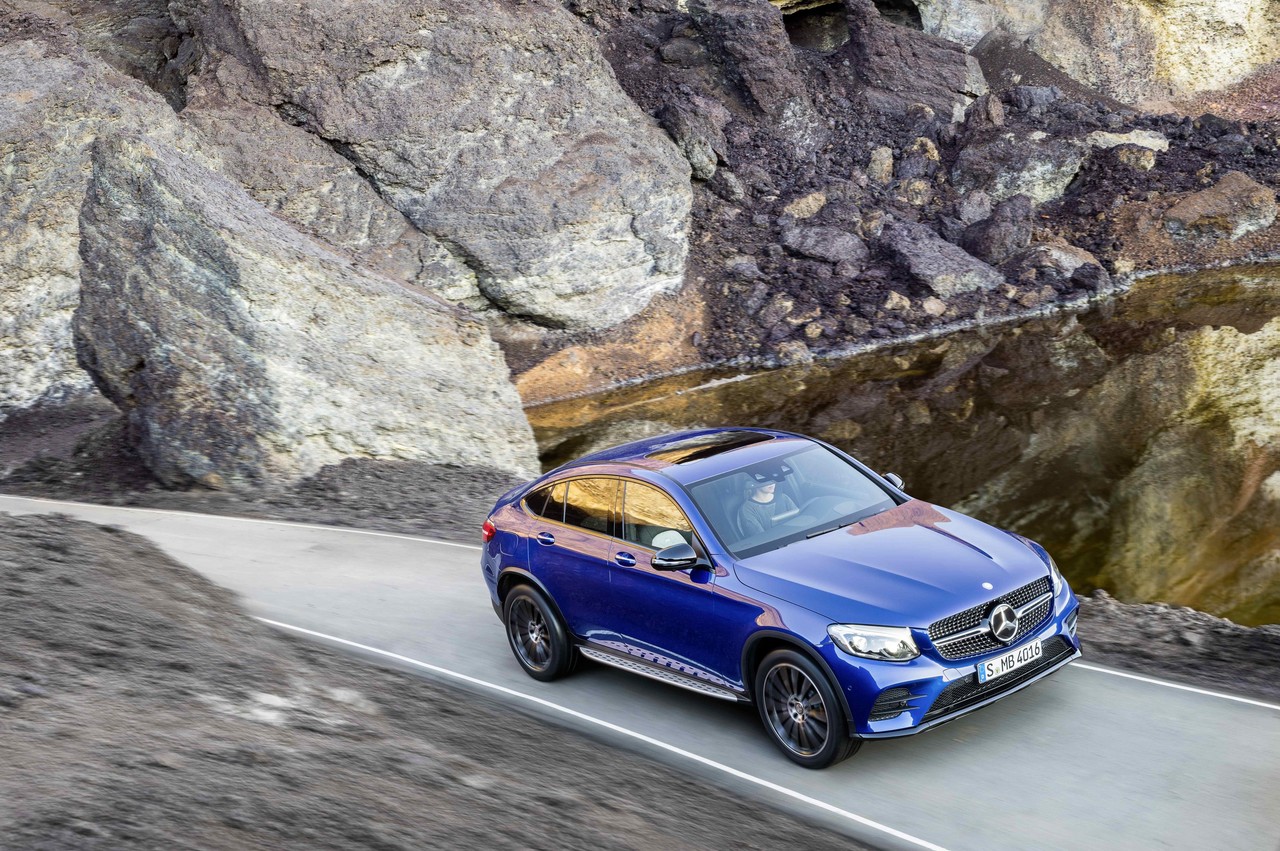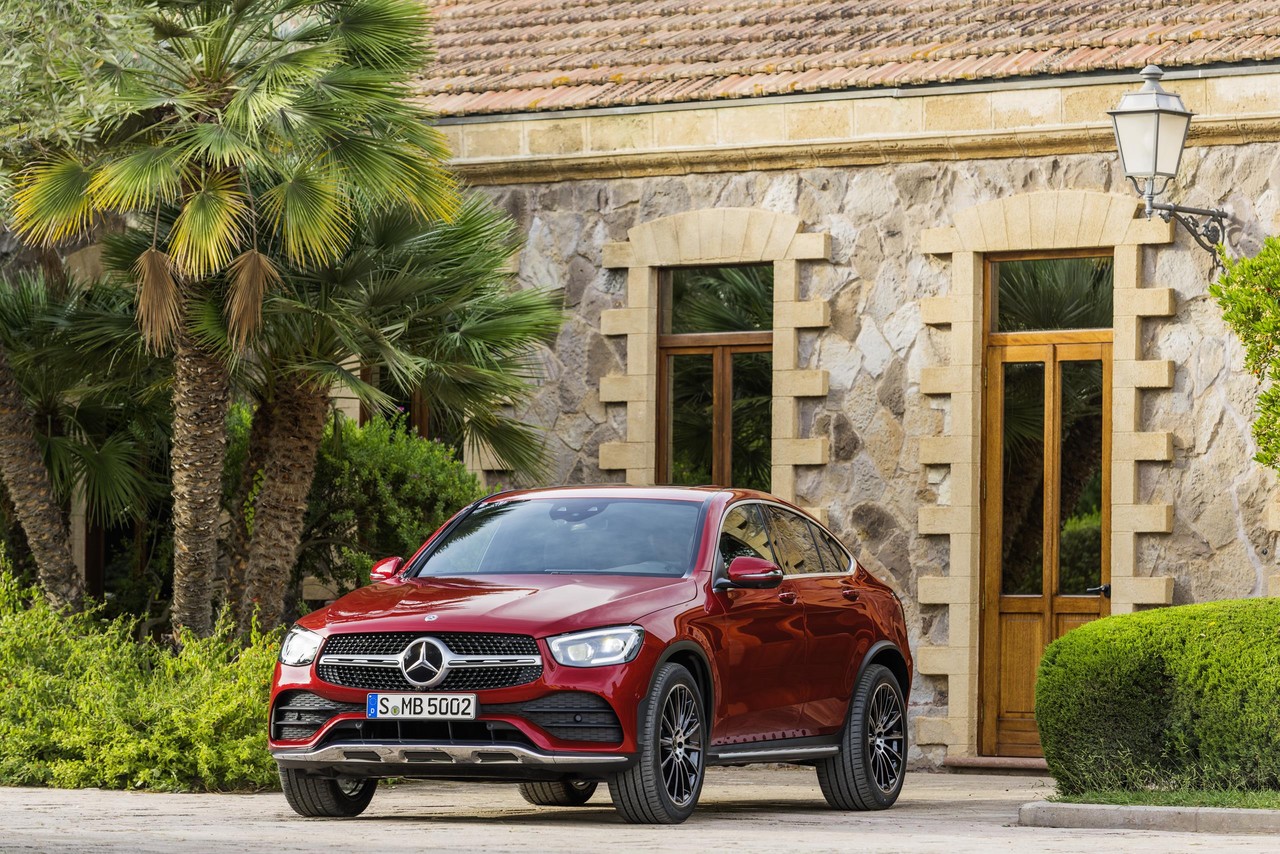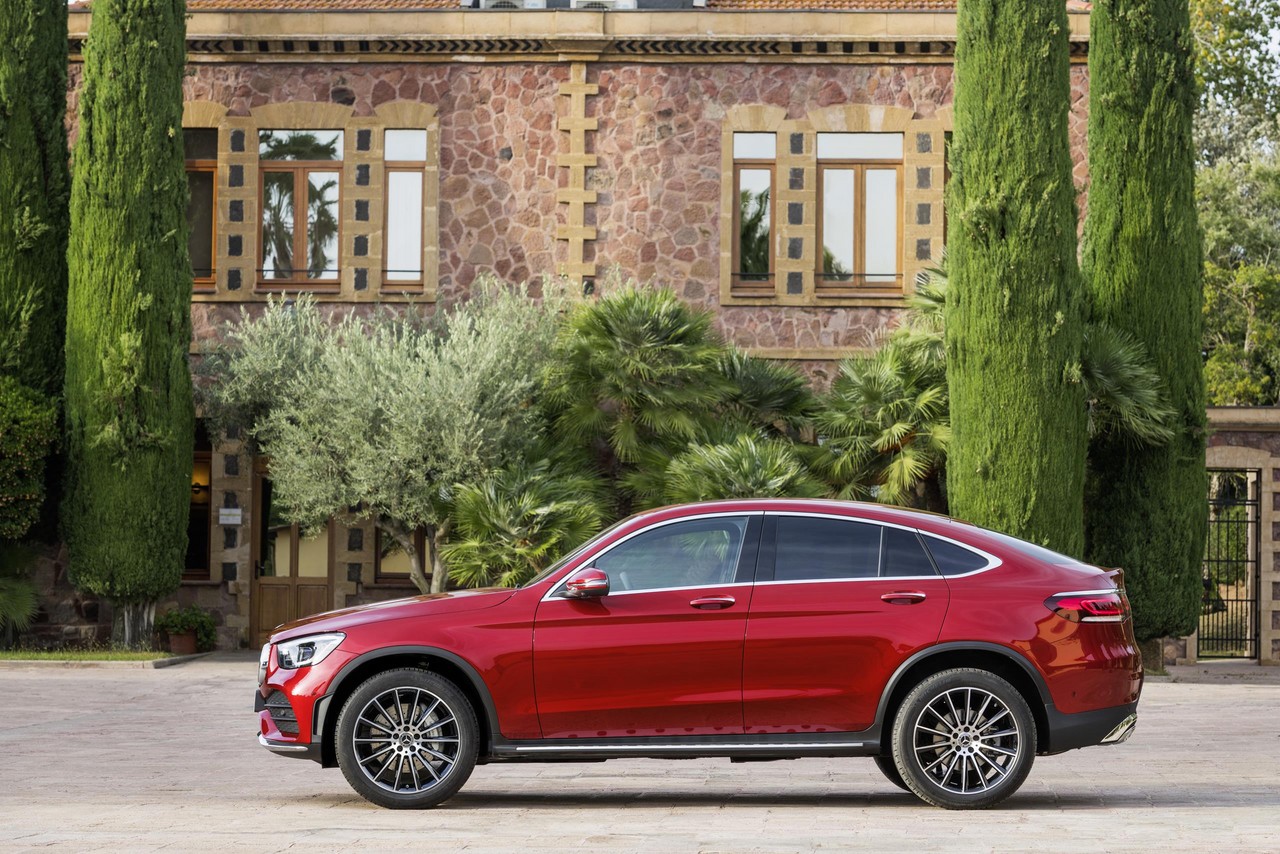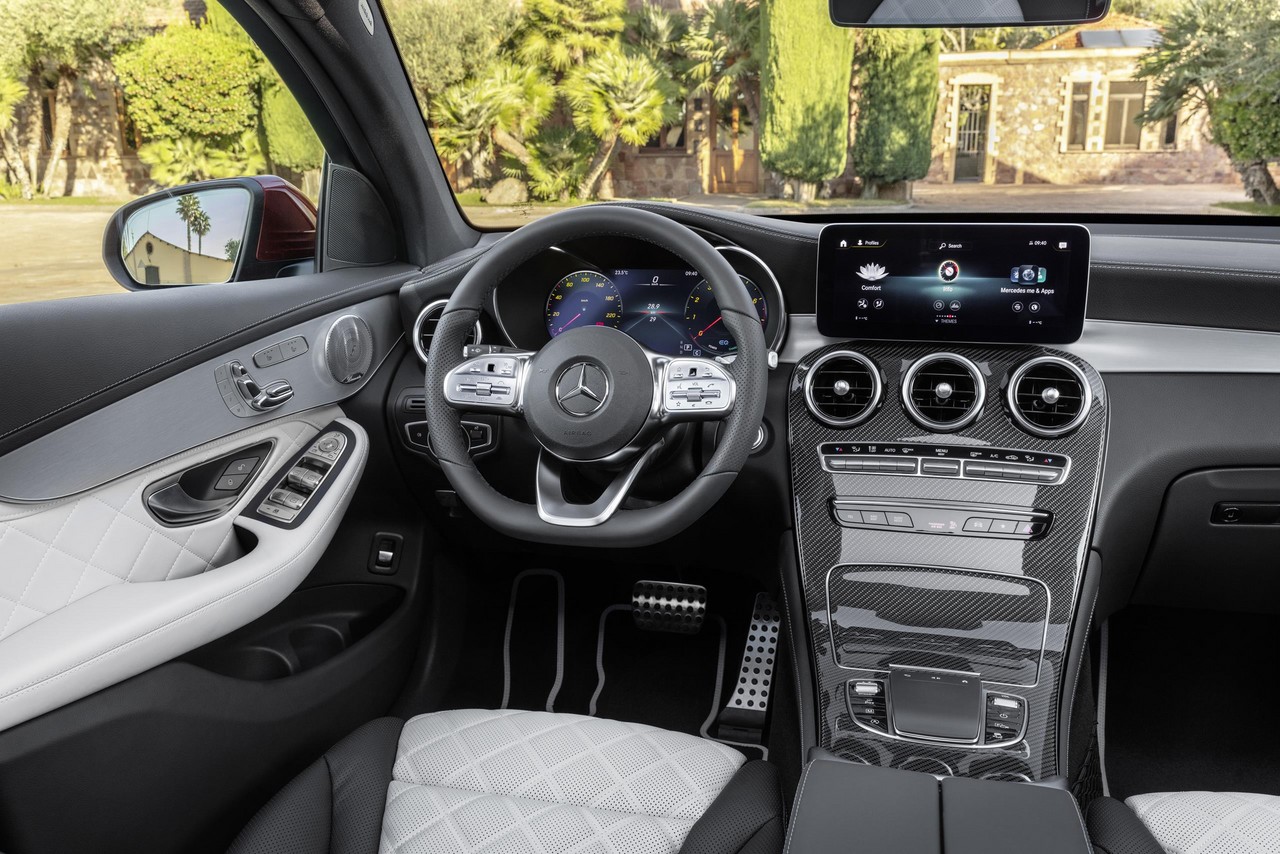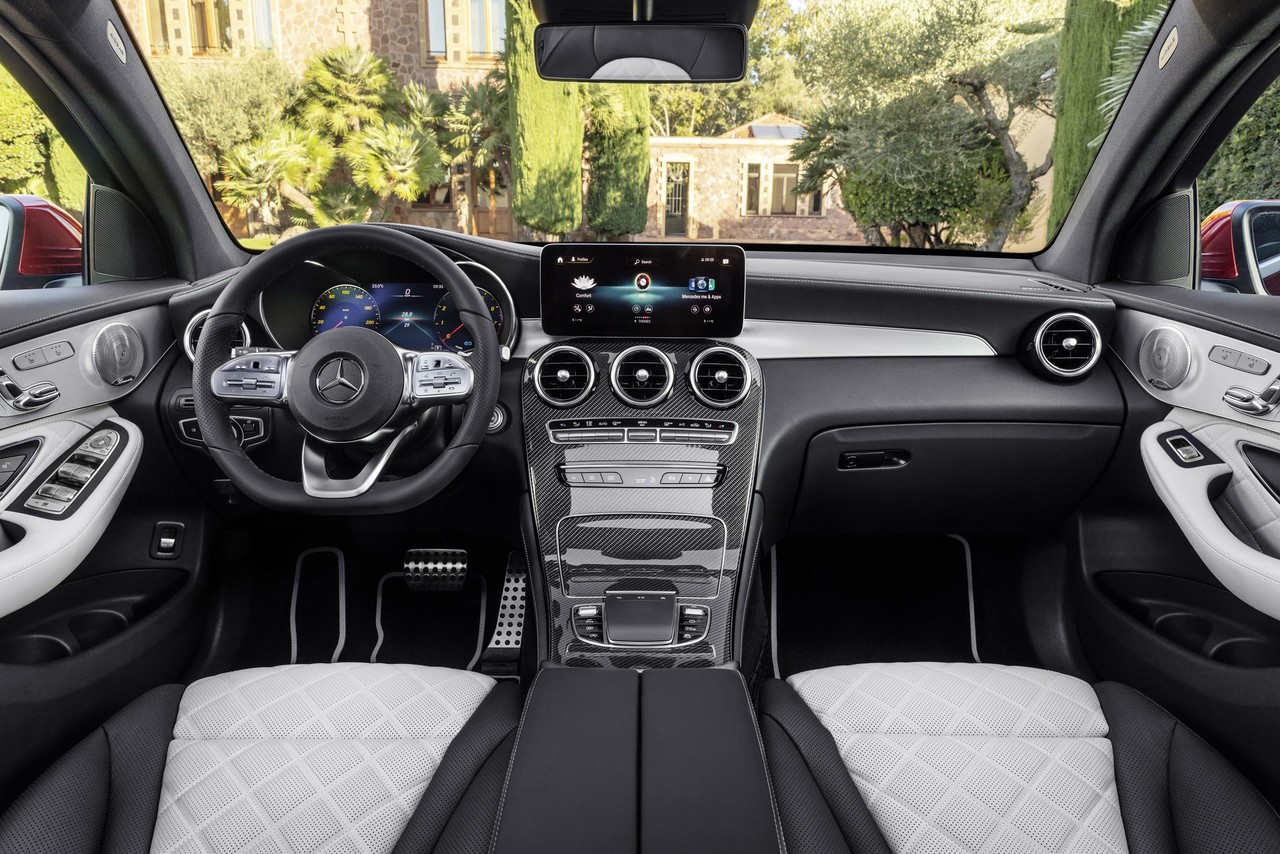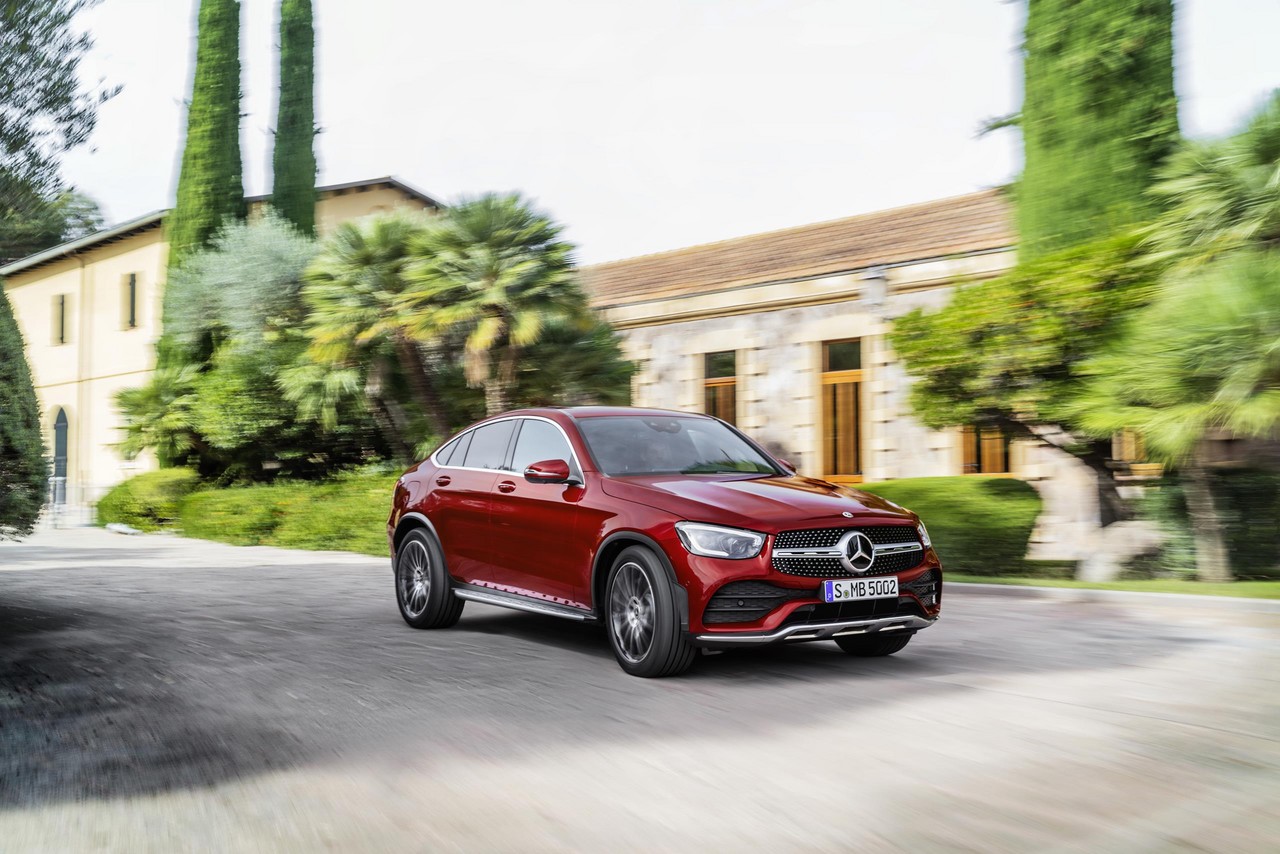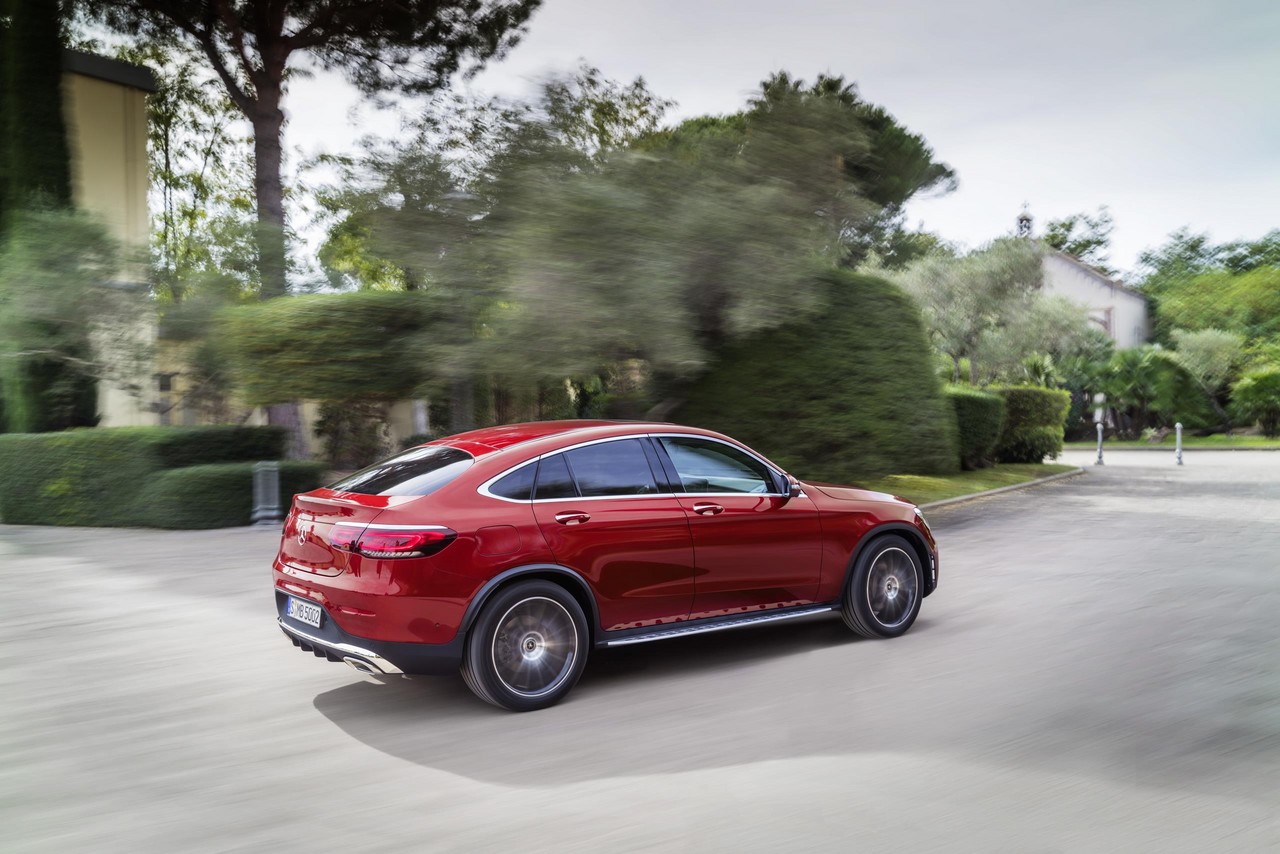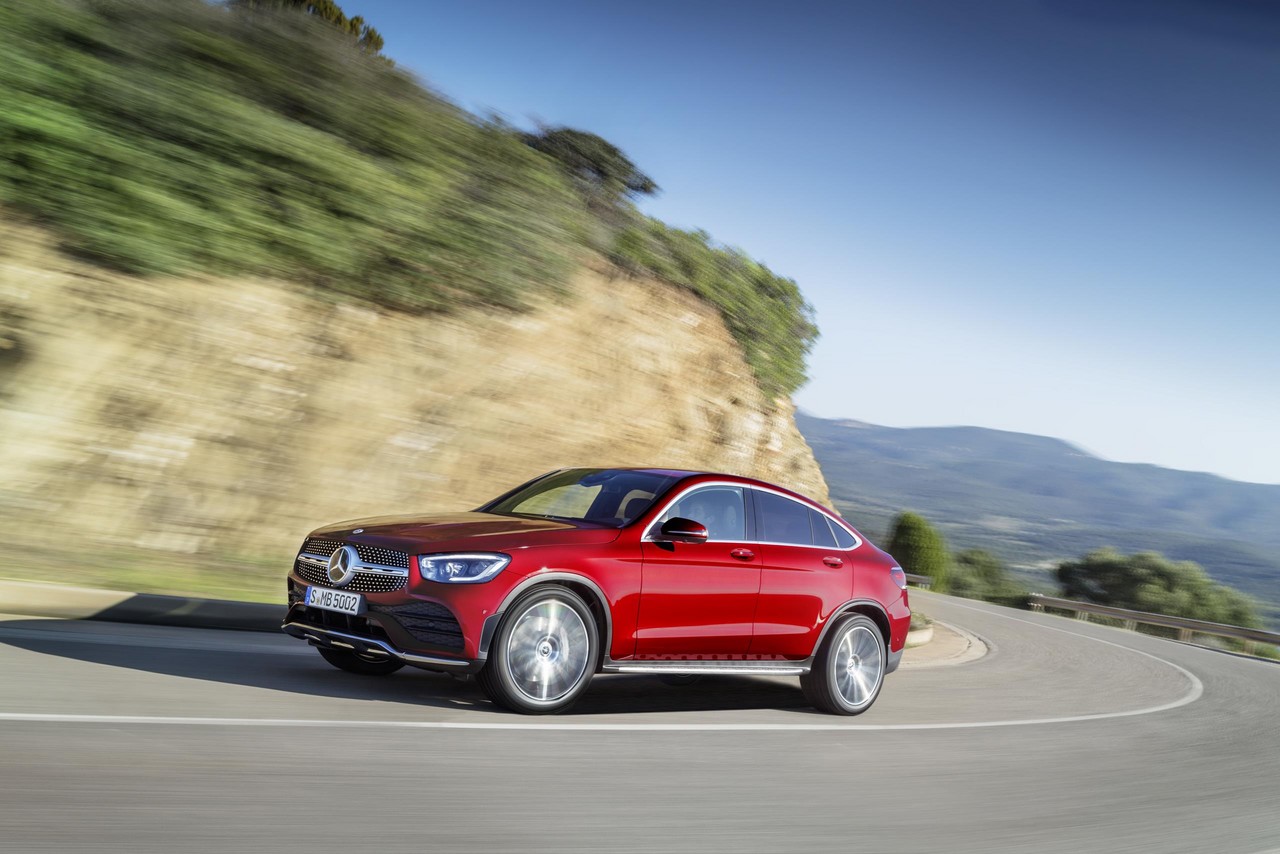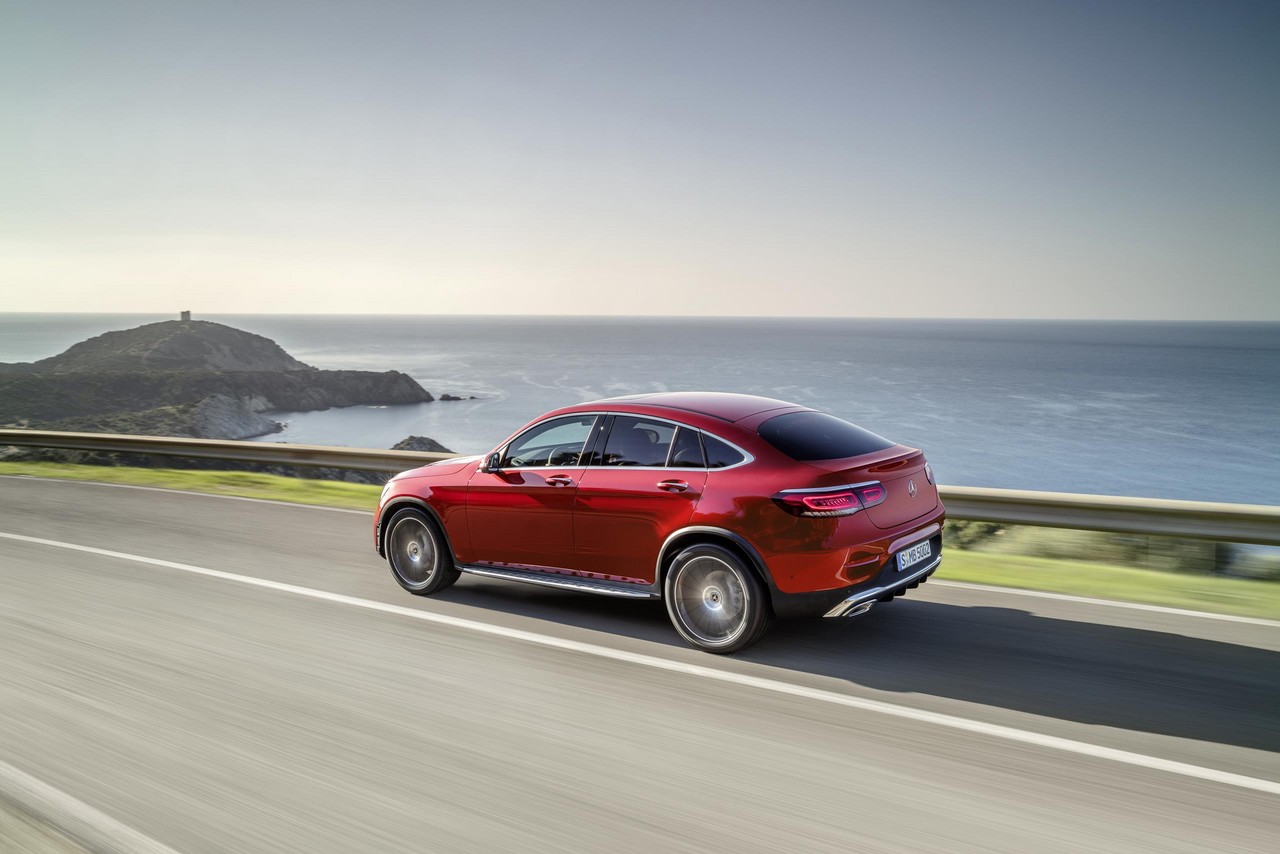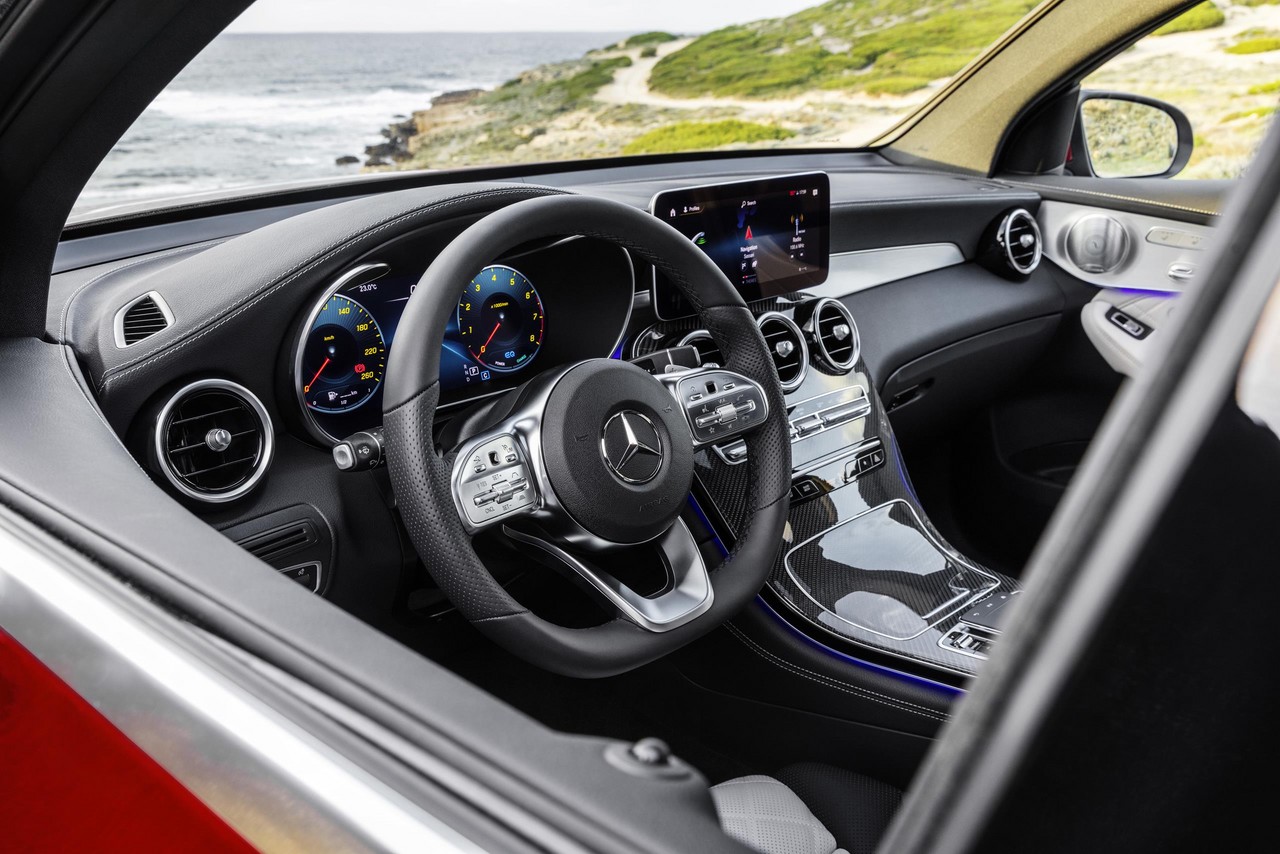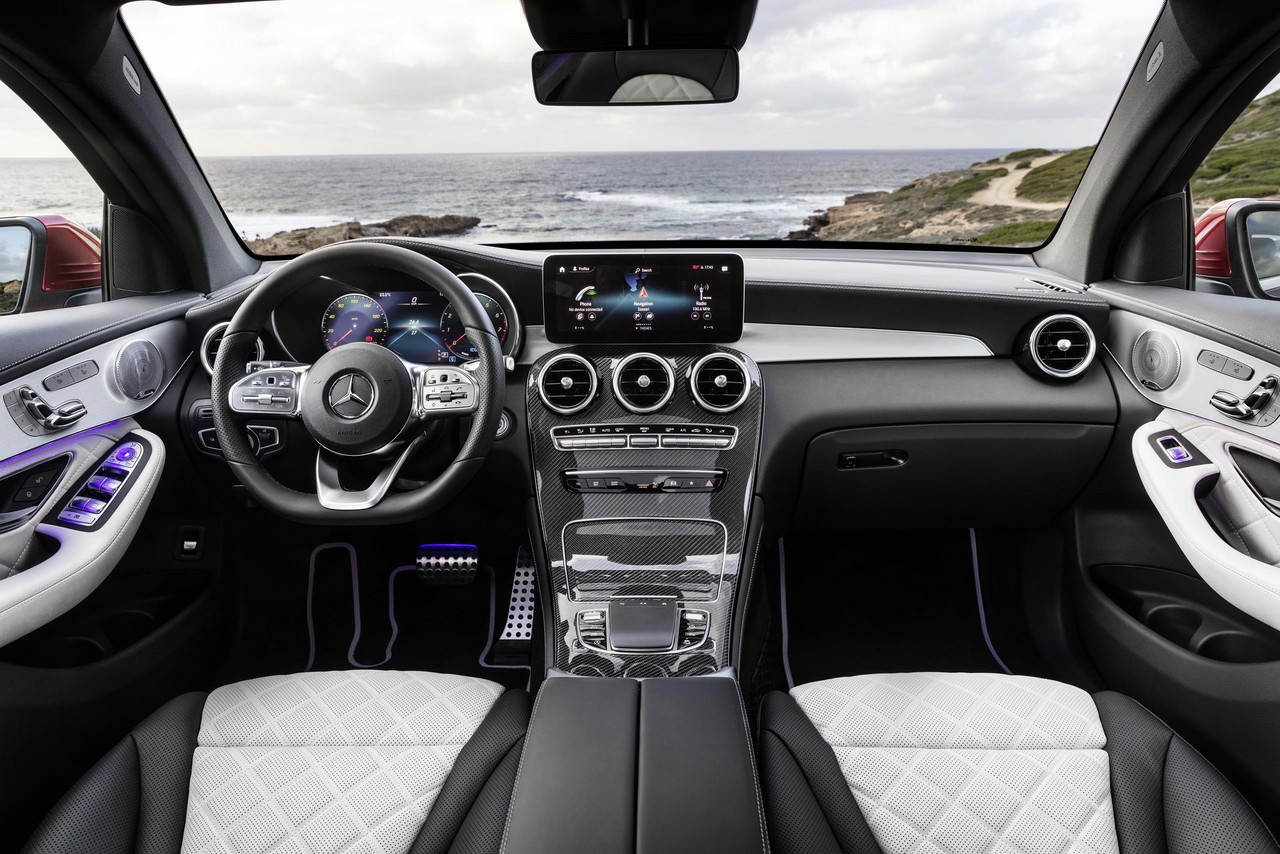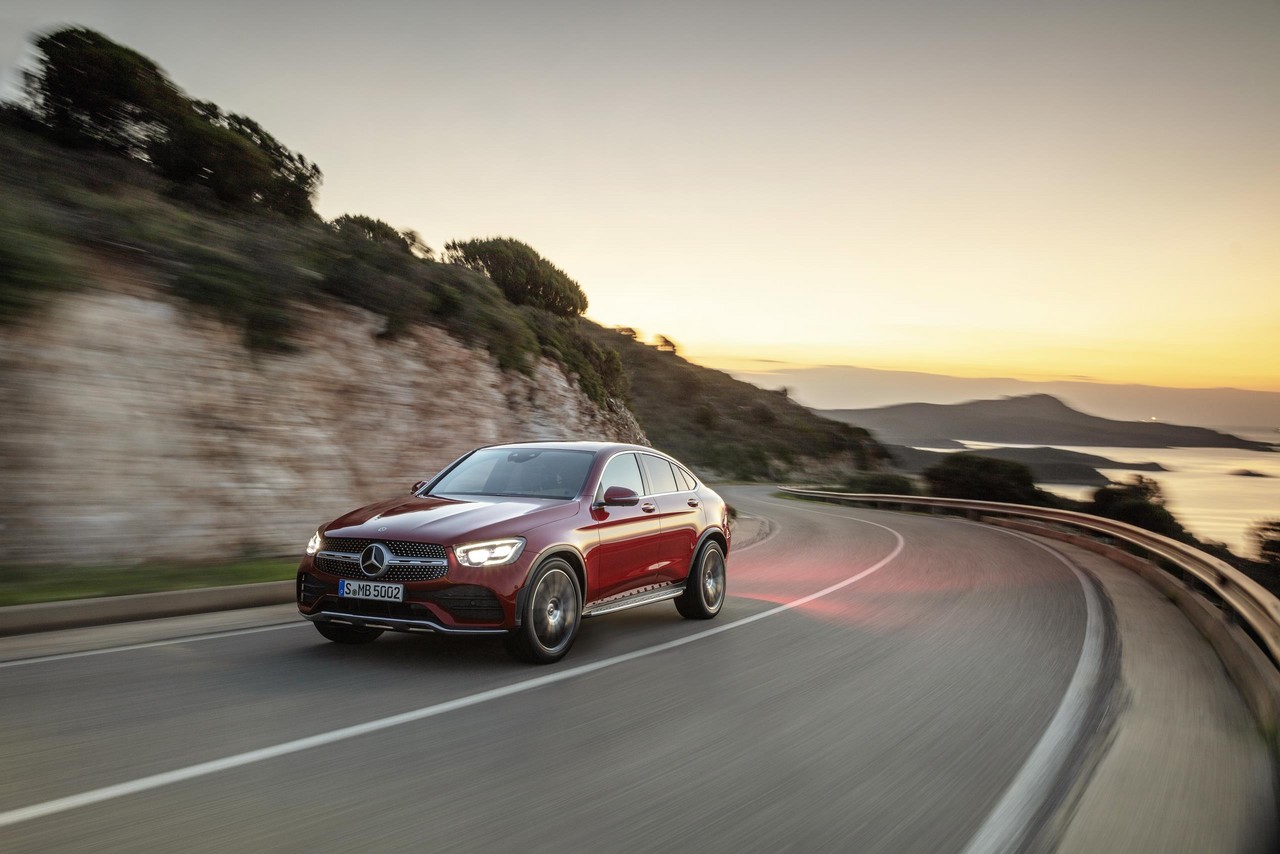
- Fuel-efficient diesel powertrains
- Accomplished dynamics
- High standard of interior fit and finish
- On 20-inch alloy wheels, suspension lacks compliance
- Reports of front-end judder (‘crabbing’/tyre skip) during low-speed manoeuvres
- Turbo-diesel engines lack refinement and can have intrusive stop-start operation
- Run-flat tyres are noisy on coarse surfaces
- Raked roofline compromises practicality
Review: Mercedes-Benz C253.I GLC Coupe (2016-19)
Overview
Commencing production in June 2016, the Mercedes-Benz C253 GLC Coupe was a mid-size SUV with a raked roofline. Manufactured in Bremen, Germany, the all-wheel drive Mercedes-Benz GLC Coupe range consisted of the GLC 220 d and GLC 250 d, with the GLC 250 following in September 2016 and the GLC 350 d in December 2016.
In September 2018, the Mercedes-Benz C253 GLC Coupe range was simplified as the GLC 220 d was discontinued.
| Engine | Trans. | Peak power | Peak torque | |
|---|---|---|---|---|
| GLC 220 d | 2.1-litre twin-turbo diesel I4 (OM651) | 9sp auto | 125 kW at 3000-4200 rpm | 400 Nm at 1400-2800 rpm |
| GLC 250 | 2.0-litre turbo petrol I4 (M274 DE20) | 9sp auto | 155 kW at 5500 rpm | 350 Nm at 1200-4000 rpm |
| GLC 250 d | 2.1-litre twin-turbo diesel I4 (OM651) | 9sp auto | 150 kW at 3800 rpm | 500 Nm at 1600-1800 rpm |
| GLC 350 d | 3.0-litre OM642 turbo diesel V6 | 9sp auto | 190 kW at 3400 rpm | 620 Nm at 1600-2400 rpm |
4MATIC all-wheel drive system
For the C253 GLC Coupe, Mercedes-Benz’s 4MATIC all-wheel drive system utilised a centre planetary differential and multiple-disc clutch, with the single-stage transfer case flange-mounted on the nine-speed ‘9G Tronic’ automatic transmission. In normal conditions, the 4MATIC system provided a 45:55 front:rear torque split. When driving over low grip surfaces, the 4MATIC system could provide a basic locking force of 50 Nm between the front and rear axles to improve traction.
Dimensions
Compared to the Mercedes-Benz X253 GLC on which it was based, the C253 GLC Coupe was 74 mm longer (at 4730 mm) and 39 mm lower (1639 mm), though width (1890 mm) and wheelbase length (2873 mm) were unchanged. Furthermore, the GLC Coupe had a drag coefficient of 0.31 Cd.
Suspension
The Mercedes-Benz C253 GLC Coupe had four-link front suspension and a five-link rear axle, both with coil springs, gas-filled shock absorbers (twin tube units for the front axle) and torsion bar stabilisers. As standard, the GLC Coupe had Mercedes-Benz’s ‘Dynamic Body Control’ adaptive damping system for the front and rear axles. With Dynamic Body Control, damping forces for each wheel were adjusted to suit the driving situation and road condition. Furthermore, Dynamic Body Control enabled the driver to select from five drive modes: Eco, Comfort, Sport, Sport+ and Individual.
The Mercedes-Benz GLC 350 d, however, was equipped with Mercedes-Benz’s ‘Air Body Control’ multi-chamber air suspension which consisted of:
- Two chambers of different sizes in the spring struts of the front axle; and,
- Three chambers of different sizes in the spring struts of the rear axle.
The Air Body Control suspension adjusted, in three stages, how stiffly the suspension reacted. Air Body Control also included a continuously operating, electronically controlled damping adjustment system which adjusted damping at each individual wheel according to the driving situation (including evasive manoeuvres) and road conditions.
The Air Body Control suspension included all-round self-levelling which adjusted ride height according to vehicle speed, enabling it to reduce the vehicle’s aerodynamic drag and therefore fuel consumption. When driving on rough roads, ground clearance could also be increased via the ride height adjustment switch. For the Air Body Control suspension, the ‘Dynamic Select’ switch enabled the driver to select from Comfort, Eco, Sport, Sport+ and Individual drive modes.
Steering
The Mercedes-Benz GLC Coupe had rack and pinion steering with electric power assistance and a ratio of 15.1:1.
Safety equipment
Standard safety equipment for the Mercedes-Benz C253 GLC Coupe included dual front airbags, a driver’s knee airbag, front and rear side (thorax/pelvic) airbags, full-length curtain airbags, ABS, electronic brake force distribution, brake assist, electronic stability control, traction control and front seatbelts with pre-tensioners and load limiters.
As standard, the Mercedes-Benz GLC Coupe was equipped with the following technologies –
- Collision Prevention Assist Plus (radar-based collision warning with autonomous braking and adaptive Brake Assist): operating at speeds up to 250 km/h to monitor the traffic ahead and at speeds up to 70 km/h for stationary objects, Collision Prevention Assist would issue a visual warning (when driving at speeds over 7 km/h) and an optical warning (when driving at speeds over 30 km/h if there was a collision risk. At speeds below 105 km/h (250 km/h in conjunction with Distronic Plus), Collision Prevention Assist Plus would initially provide partial autonomous braking to reduce vehicle speed and alert the driver. Furthermore, adaptive Brake Assist would calculate the braking force required and prime the braking system for optimum response when the driver depressed the brake pedal. If the driver did not respond and a collision was unavoidable, then maximum braking force would be applied to reduce vehicle speed. At initial vehicle speeds of up to 40 km/h, rear-end collisions could be prevented;
- Brake Assist Plus: used a 24 GHz radar sensor with a range of 30 metres and a 77 GHz radar sensor with a range of 200 metres to monitor the distance to the vehicle ahead and would warn the driver if there was a risk of a collision. Brake Assist Plus could detect vehicles when travelling at speeds up to 200 km/h, and stationary objects when the driver was travelling at 7 km/h to 72 km/h. Significantly, Brake Assist Plus could calculate the necessary brake force assistance to prevent a rear-end collision, build up that pressure in the braking system and provide it as soon as the brake pedal was depressed for ‘the best possible deceleration’;
- Blind spot assist (passive): used two radar sensors in the rear of the vehicle to warn the driver before an indicated lane-change if a vehicle is in the driver’s blind spot;
- Mercedes-Benz’s ‘Pre-Safe’ which prepared the vehicle for a collision by deploying the seatbelt tensioners, closing the side windows and sunroof (where fitted) and adjusting the front seats for optimum deployment of the restraint system. Pre-Safe was activated by emergency braking, panic braking, pronounced over- or under-steering, critical steering movements or heavy support by the adaptive Brake Assist system;
- Attention Assist with drowsiness detection: operates at speeds in excess of 80 km/h and assesses driver behaviour (including steering movements) for signs of drowsiness. If detected, the driver is provided with visual and audible warnings;
- An ‘active’ bonnet: prior to a pedestrian collision, a pyrotechnic charge would deploy to raise the height of the bonnet and create clearance over ‘hard points’ in the engine bay.
Beyond this, the GLC 250 Coupe, GLC 250 d Coupe and GLC 350 d Coupe were further equipped with:
- Distronic Plus (adaptive cruise control with brake warning): an ‘adaptive’ cruise control system which used two short-range radar sensors positioned behind the front bumper to monitor the road up to 30 metres ahead, and a long-range radar located behind the radiator grille which had a range of 200 metres. Operating at speeds up to 200 km/h, Distronic Plus used an electronic control unit to analyse the information from both radar systems to calculate the engine, automatic transmission and braking parameters required for proximity control. As such, Distronic Plus could automatically apply the brakes to prevent the vehicle from becoming too close to traffic ahead (the time interval could be specified) and accelerate back to the set speed when traffic allowed. To accelerate from rest, the driver only needed to operate the Distronic stalk on the steering column or briefly depress the accelerator pedal. With Distronic Plus, automatic deceleration of up to four (4) m/s2 was possible. If Distronic Plus detected that heavier braking was required, a warning light would illuminate in the instrument cluster and be accompanied by an audible warning. Furthermore, the electronic proximity control system could be activated independently of Distronic Plus at speeds over 30 km/h to alert the driver if they were approaching another vehicle too rapidly;
- Steering Assist with Stop&Go Pilot: operating in conjunction with Distronic Plus and at speeds up to 130 km/h, Steering Assist used a stereo camera located behind the windscreen to detect road markings, while the Stop&Go Pilot operated at speeds up to 60 km/h and enabled the system to use the vehicle in front or road markings as a means of orientation. If the vehicle was detected to be drifting out of its lane, Steering Assist would warn the driver and provide steering intervention to keep the vehicle in its lane;
- Pre-Safe Plus: could anticipate rear-end collisions and warn following traffic by activating the rear hazard lights at high frequency. The Pre-Safe system would then deploy occupant protection measures and apply the vehicle’s brakes to prevent secondary accidents;
- BAS Plus with Cross-Traffic Assist: used a 24 GHz radar sensor with a range of 30 metres and a 77 GHz radar sensor with a range of 200 metres to monitor the distance to the vehicle ahead and would warn the driver if there was a risk of a collision. Brake Assist Plus could detect vehicles when travelling at speeds up to 200 km/h, and stationary objects when the driver was travelling at 7 km/h to 72 km/h. Significantly, Brake Assist Plus could calculate the necessary brake force assistance to prevent a rear-end collision, build up that pressure in the braking system and provide it as soon as the brake pedal was depressed for ‘the best possible deceleration’. The Cross-Traffic Assist function could operate at speeds up to 72 km/h and used the stereo camera and radar sensors to detect traffic that was crossing in front of or behind the vehicle. If detected, the driver would receive visual and audible alerts;
- Active Blind Spot Assist: active at speeds above 60 km/h, a corrective braking force would be applied to the wheels on one side of the vehicle if the driver attempted to change lanes when a vehicle was detected in the driver’s blind spot; and,
- Active Lane Keeping Assist: vibrated the steering wheel as the vehicle approaches a continuous lane marking line and, if crossed, automatically braked the wheels on one side of the vehicle to return the vehicle to its lane.
Euro NCAP testing
In Euro NCAP testing , the related 2015 Mercedes-Benz X253 GLC 220 d 4MATIC received a five star safety rating which included a 95 per cent adult occupant protection rating and an 89 per cent child occupant rating. In the frontal offset test, occupant protection was generally rated as good, although chest and lower right leg protection was rated as adequate (i.e. a slight risk of serious injury). In the side impact and pole tests, however, maximum points were awarded.
Features: Mercedes-Benz GLC 220 d Coupe
Standard features for the Mercedes-Benz C253 GLC 220 d Coupe included 20-inch AMG multi-spoke alloy wheels, ‘Audio 20’ sound system with five speakers, a seven-inch TFT display, touchpad control, a CD player with MP3/WMA/AAC compatibility, a digital radio tuner (DAB+), and Bluetooth mobile phone connectivity and audio streaming, a media interface (iPod/iPhone integration and two USB ports), a Garmin satellite navigation system, ‘Artico’ synthetic leather upholstery, power adjustable front sports seats with horizontal quilting, ‘Thermatic’ dual-zone climate control air conditioning, cruise control with variable speed limiter (‘Speedtronic’), dusk-sensing headlights, rain-sensing wipers, a leather-wrapped steering wheel with gearshift paddles, 40:20:40 split fold rear seats, remote central locking, power adjustable and heated door mirrors with folding function, power windows, a height and reach adjustable steering column, push-button start, an electric park brake, an auto-dimming rear view mirror, ambient interior lighting, illuminated front door sill panels, reading lights (front and rear), black-ash open pore wood trim, brushed stainless steel AMG sports pedals, brushed aluminium side steps, a cargo cover, tyre pressure monitoring, a trip computer and an immobiliser.
As standard, the C253 GLC Coupe was equipped with LED headlights and Mercedes-Benz’s ‘LED Intelligent Light System’ which provided variable lighting and five selectable programs: motorway mode, cornering light function, camera-based active light function, roundabout light function and enhanced fog light function. The system also included ‘Adaptive Highbeam Assist Plus’ which automatically dipped the high beam headlights when traffic was detected to avoid dazzling other drivers.
The C253 GLC Coupe was also equipped with:
- A 360 degree camera system which provided a bird’s eye view of the vehicle on the centre display and dynamic guidelines; and,
- Parking Pilot with Parking Assist: automatically engaged when driving at speeds up to 30 km/h, Parking Pilot could identify parallel and right angle parking spaces. Furthermore, the Parking Assist function could provide automated steering to manoeuvre the vehicle into the space while the driver controlled vehicle speed.
Features: Mercedes-Benz C253 GLC 250 and 250 d
Compared to the GLC 220 d, the GLC 250 Coupe and 250 d Coupe were further equipped with leather upholstery and had keyless access.
Features: Mercedes-Benz C253 GLC 350 d Coupe
The range-topping Mercedes-Benz GLC 350 d Coupe was equipped with the COMAND Online media system which included a 21.3 cm TFT display, HDD navigation with real-time traffic updates, a CD/DVD player, 10 GB music register, Bluetooth interface, ‘Linguatronic’ voice recognition and internet access. Beyond this, the GLC 350 d Coupe was also fitted with a 590 watt Burmester surround sound system which had thirteen speakers and a nine-channel digital sound processing (DSP) amplifier.
Specifications
Related links
Review: Mercedes-Benz C253.II GLC Coupe (2019-23)
Overview
The Mercedes-Benz C253.II GLC Coupe was released in Australia in September 2019. The C253.II GLC Coupe range consisted solely of the GLC 300 4MATIC model as the GLC 250, GLC 250 d and GLC 350 d were withdrawn.
MBUX and styling
Inside, the C253.II GLC Coupe featured the ‘Mercedes-Benz User Experience’ (MBUX) infotainment system. For Australian-delivered vehicles, MBUX included a
10.25 inch diameter (1920 x 720 pixels) central touchscreen, a 12.3-inch instrument display for the instruments and a multi-functional touchpad on the centre console (replacing the rotary push-button). The new steering wheel also had touch-sensitive controls which enabled the driver to control both MBUX displays.
Visually, the Mercedes-Benz C253.II GLC Coupe could be identified by its smaller and more raked LED headlamps with modified contours, new rear diffuser with underride guard and redesigned LED tail lamps.
Mechanical changes
For the C253.II GLC 300, the petrol engine had a 48-volt on-board electrical system (Mercedes-Benz’s ‘EQ Boost’) and a belt-driven starter-generator. The latter was responsible for hybrid functions such as ‘boost’ (provided up to 10 kW at engine speeds below 2500 rpm), energy recuperation and a sailing mode.
| Engine | Trans. | Peak power | Peak torque | |
|---|---|---|---|---|
| GLC 300 4MATIC | 1991 cc M264 turbo petrol I4 | 9sp auto | 190 kW at 5800-6100 rpm (+10 kW electric motor) |
370 Nm at 1800-4000 rpm |
Safety equipment
Compared to the Mercedes-Benz C253.I GLC Coupe, passive safety technologies for the C253.II GLC Coupe were unchanged.
Beyond this, the Mercedes-Benz C253.II GLC 300 Coupe was equipped with the following active safety technologies –
- Active Brake Assist (previously ‘Collision Prevention Assist Plus’);
- Blind Spot Assist (passive);
- Rear Cross-Traffic Alert;
- Pre-Safe accident anticipatory system;
- Traffic Sign Assist; and,
- Attention Assist.
Furthermore, the Mercedes-Benz C253.II GLC 300 was equipped with a ‘Driver Assistance Package’ – as standard – which included the following –
- Active Distance Assist Distronic with Active Steering Assist: operating at speeds up to 210 km/h, the system could maintain a pre-set distance to the vehicle ahead. A stop-and-go function also enabled the vehicle to be braked until stationary, remain stationary for up to 30 seconds and then accelerate when the traffic ahead started moving. Active Distance Assist Distronic also combined navigation data with camera/radar inputs to adjust speed when approaching bends, junctions or roundabouts. Active Steering Assist helped the driver in keeping the vehicle in the centre of its lane by applying steering wheel torque, using lane markings for orientation at speeds up to 210 km/h and, at speeds up to 130 km/h, also used the position of vehicles ahead;
- The Cross-Traffic Assist: operated at speeds up to 72 km/h and used the stereo camera and radar sensors to detect traffic that was crossing in front of or behind the vehicle. If detected, the driver would receive visual and audible alerts;
- Evasive Steering Assist: operating at speeds from 20-70 km/h, Evasive Steering Assist could help the driver avoid a pedestrian that was detected by the radar sensors and stereo camera. If the driver initiated an evasive manoeuvre by turning the steering wheel, the system provided ‘precisely calculated steering torque to support the movement of the steering wheel’ to avoid the pedestrian and then straighten the vehicle;
- Active Lane Keeping Assist: operating at speeds from 60 km/h to 200 km/h, Active Lane Keeping Assist warned the driver if the vehicle was unintentionally drifting out of its lane via pulsed vibrations through the steering wheel. If the vehicle crossed a continuous line, the system could pull the vehicle back into its lane by applying the brakes on one side of the vehicle. In the case of a broken line, such intervention would occur only when there was a collision risk with a vehicle in the adjacent lane (including oncoming traffic);
- Active Lane Change Assist: operating at speeds from 80 km/h to 180 km/h, Active Lane Change Assist could perform lane changes – within 10 seconds – in response to the driver nudging the indicator stalk;
- Active Blind Spot Assist: at speeds from 12 km/h to 200 km/h, the system could provide a visual alert and audible alarm if there was a risk of a side collision when the turn indicator was actuated. As part of the Driving Assistance Package, the brakes on one side of the vehicle could be applied when travelling at speeds above 30 km/h to avoid a side collision; and,
- Pre-Safe Plus: used the rear radar sensors to detect if a rear-end collision was imminent and, if so, flashed the rear hazard lights and prepared occupant protection measures such as the seatbelt tensioners. If the vehicle was stationary and the risk of a collision persisted, the system could apply the vehicle’s brakes to reduce the risk of injuries by reducing the forward jolt caused by an impact from the rear.
Features: Mercedes-Benz C253.II GLC 300 Coupe
Key features for the Mercedes-Benz C253.II GLC 300 Coupe included dual-zone climate control, ‘Artico’ (synthetic leather) upholstery, power adjustable front seats, Multi-Beam LED headlights with Adaptive Highbeam Assist Plus, a proximity key and push-button start (‘Keyless Go’), ambient lighting with 64 different colours, two USB ports in the second row of seating, wireless charging for compatible mobile devices and rear privacy glass.
For a complete list of features, please see the ‘Specifications’ document, below.
Specifications
